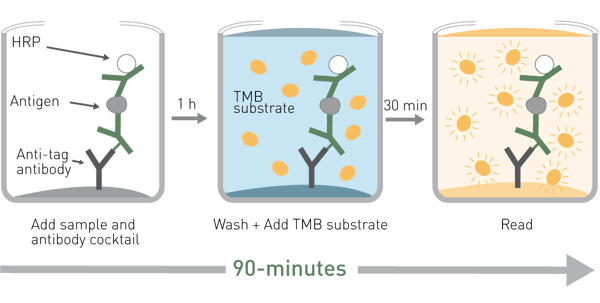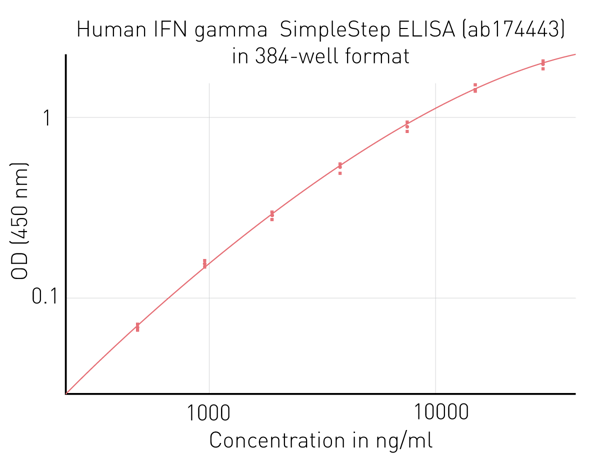Introduction
After more than 40 years, the enzyme-linked immuno-sorbent assay (ELISA) is still considered to be one of the most reliable assays, and often considered a gold standard, for the detection and quantifi cation of proteins and other analytes in various biological samples. Traditional ELISA methods require several wash steps and relatively long turn-around times (3-5 hours) as well as high sample volumes, making them more challenging to adapt to high-throughput processes.
Abcam’s SimpleStep ELISA technology streamlines the process to a semi-homogeneous format that results in a simple 90-minute, single-wash protocol1. For higher throughput demands, SimpleStep ELISA can be miniaturised to a 384-well format allowing up to 4 times more samples to be processed in the same amount of time. When read on BMG LABTECH’s PHERAstar FSX higher throughput is achieved, whilst maintaining high sensitivity, with each well read in under a second. BMG LABTECH’s MARS data analysis allows the automatic generation of quantitative standard curves and quantitation of unknown samples.
Here we describe how SimpleStep ELISA in 384-well format can be used in conjunction with the PHERAstar FSX to quantify human IgG and human Interferon gamma (IFN gamma), two important targets in pharmacokinetic studies and immunotherapeutic drug safety testing.
Assay Principle
The sandwich ELISA uses an antibody pair that binds to distinct parts of the analyte. One antibody coats the bottom of the well and serves to capture the analyte. Following capture, and requisite washing, the detector antibody is added. Finally, after additional washing, the detection can be performed.
Figure 1 shows how SimpleStep ELISA technology enables the sandwich ELISA to be performed semi-homogeneously by the addition of an immobilization antibody. The simple 90-minutes protocol remains the same whether performed in 96- or 384-well plate format.
Materials & Methods
- 384-well SimpleStep ELISA microplate (ab203359)
- SimpleStep ELISA kits (Abcam)
- Human IgG ELISA kit (ab195215)
- Human IFN gamma ELISA kit (ab174443)
- PHERAstar FSX (BMG LABTECH)
Experimental procedure
For all kits, samples were handled in accordance with instructions for use in 384-well format in a total volume of 50µl2. Two 96-well SimpleStep ELISA kits are necessary to run a full 384-well plate. For all tests, standard curves were prepared based on a 7-point dilution series using duplicate or triplicate samples.
The plates were incubated with 3,3′,5,5′-Tetramethyl-benzidine (TMB) for 10 minutes for human IgG and 5 minutes for human IFN gamma. The plates were read on the PHERAstar FSX using high precision protocol and the following settings.
Instrument Settings
| Optic settings |
Absorbance, Endpoint |
|
|
Wavelength |
450 | |
|
General settings |
Number of flashes |
22 |
|
Settling time |
0.2 s |
|
Results & Discussion
After each plate was read on the PHERAstar FSX the data were analysed in MARS to plot the standards and apply a curve fit.
Measurement of human IgG is an important indicator used in antibody expression studies. The Human IgG SimpleStep ELISA kit is validated in serum, plasma, cell culture supernatant, and tissue lysate. It is particularly useful in pharmacokinetic (PK) studies. The IgG ELISA measured in 384-well format is shown in Figure 2.
Human IFN gamma is a key factor for assessing T cell responses, many of which are relevant to the immunological synapse which is highly important in cancer and immuno-oncology. Examples of such assays would be mixed lymphocyte assays (MLR), T cell co-stimulation, or recall assays. The Human IFN gamma SimpleStep ELISA kit is validated in serum, plasma, and cell culture supernatant. The 384-well ELISA measurement is depicted in Figure 3.
Conclusion
The SimpleStep ELISA kit in 384-well microplate format allows processing up to 4 times more samples and generation of results in 90-minutes on smaller sample volume (50 µl). The high sensitivity, specificity, and reproducibility expected with SimpleStep are delivered in the 384-well format. The time-saving protocol attributes, coupled with associated cost-saving make this unique ELISA solution ideal for high-throughput needs.
The spectrometer-based absorbance measurements on the PHERAstar FSX allow one or more wavelengths to be measured in less than a second per well, with automatic generation of the standard curve and recalculation of unknown samples with BMG LABTECH´s MARS data analysis package adding to the time savings achieved with a more simplified workflow.
References
- Highly sensitive ELISAs in 90-minutes: SimpleStep ELISA® kits and the SPECTROstar® Nano –BMG LABTECH Application note 341
- 384-Well SimpleStep ELISA® Microplate protocol.
- Huse M, et al. T cells use two directionally distinct pathways for cytokine secretion. Nat Immunol. 2006 Mar;7(3):247-55
SimpleStep ELISA is a registered trademark of Abcam



